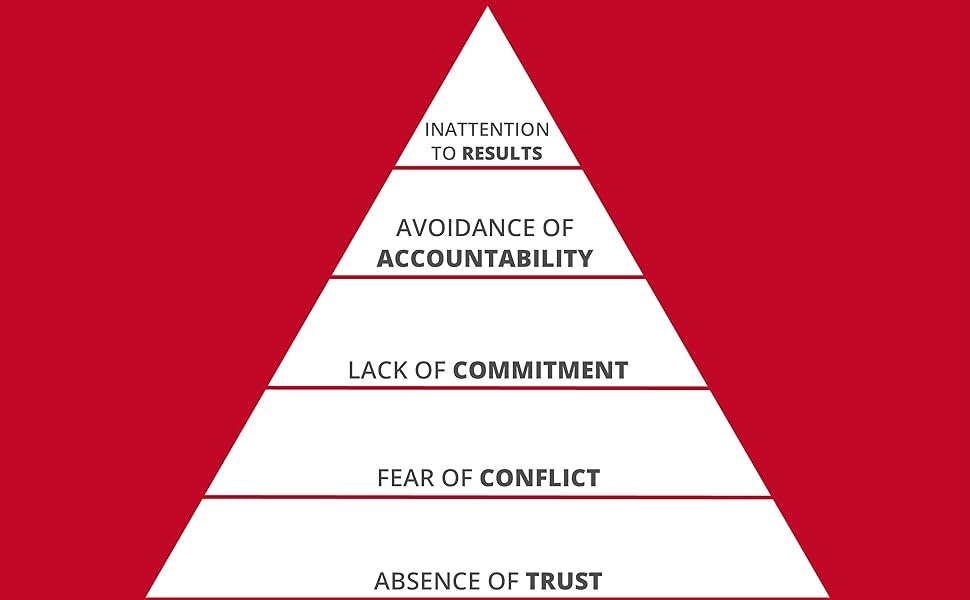The 5 Dysfunctions of a Team Explained
In his book “The 5 Dysfunctions of a Team”, Patrick Lencioni identifies five common pitfalls which can prevent a team from performing to the best of its ability.
The dysfunctions – the absence of trust; fear of conflict; lack of commitment; avoidance of accountability; and inattention to results – are commonly shown in a pyramid, demonstrating the link between the issues.
Let’s look at each one in turn.
Absence of trust
Trust is at the bottom of Lencioni’s pyramid because it is the foundation on which all good teams are built.
Dan Crompton, one of our business coaches, explains: “If you lose trust, the rest is gone. If you don’t trust your team, and if your team don’t trust you, then forget the rest!”.
When there is an absence of trust, team members find it difficult to show vulnerability and open up to one another. Individuals might hide their weaknesses and be scared to admit their mistakes. You’ll also often find that:
- Team members don’t ask one another for help
- Individuals struggle to share constructive feedback
- Disagreements never get resolved
- The team ends up disliking spending time together – both in the workplace and other social settings
While we won’t pretend it’s easy, trust is something that can be intentionally built in a team.
Leaders must light the way by demonstrating vulnerability to their team. Personal histories exercises (where individuals share memories, experiences, and stories in order to get to know each other as people) can be helpful but most of all you need to become a role model for others – somebody who admits their mistakes openly, keeps their promises and who is willing to show their vulnerable authentic self to others.
Some resources that have helped clients here are the books Radical Candor, Non-Violent Communication and The 15 Commitments of Conscious Leadership.
Fear of conflict
When constructive conflict is encouraged, teams enjoy lively and exciting meetings and share their opinions to solve problems quickly. They don’t shy away from tricky conversations – important topics are open for discussion.
The opposite is true of teams which fear conflict. Difficult – but often essential – topics are avoided, leading to dull, unproductive meetings. So how can a team become comfortable with healthy conflict in order to debate each other’s ideas and ultimately make better decisions?
Once again, the team leader plays a critical role. They must create an environment where team members feel supported to speak up and challenge each other in the moment rather than waiting for conflicts to fester and grow – this is known as ‘real-time permission’.
Leaders can also facilitate ‘conflict mining’ (which is not as scary as it sounds!). This involves actively seeking out differing opinions and conflicting perspectives and encouraging team members to share them openly and honestly.
Lack of commitment
Teams which suffer from a lack of commitment can be characterised by:
- Ambiguity over direction and priorities
- Over-analysis and delaying of decision-making, leading to windows of opportunity closing
- A lack of confidence and a fear of failure
- The revisiting of the same topics over and over again
- A lack of clarity, leading to second-guessing by individuals
Does this sound familiar? Do you find that your team often misses opportunities? Does it feel like only some individuals are fully committed?
By ensuring every team member receives the same information regardless of their position in the business hierarchy, the reliance on second-guessing can be replaced with well-thought-out decisions.
Leaders should avoid placing too much importance on consensus – not everyone has to agree with everyone else, and all team members should feel motivated to share their opinion for the good of the team.
Avoidance of accountability
When team members don’t hold each other accountable through fear of upsetting others or causing rifts, it can lead to a lack of ownership and responsibility.
You’ll often find teams which lack accountability perform poorly, miss deadlines and fail to meet targets. Team members who have high standards often resent those who don’t. And everyone looks to the team leader to raise issues, rather than peers feeling they can give each other feedback.
It’s easy to see why Dan says accountability “can be scary when things are going wrong” But accountability doesn’t need to be about placing blame or pointing the finger when something bad happens.
Instead, a team where peer-to-peer accountability is encouraged can identify and solve problems quickly. Members respect one another, and everyone is held to the same high standards – meaning that everyone feels part of the success when something fantastic happens, too!
If you feel like one or more of your teams is suffering from a lack of accountability, try:
- Publishing goals and expected standards
- Conducting simple and regular progress reviews
- Providing team rewards
Inattention to results
Teams suffering from this dysfunction may be disjointed, with individuals focussing more on their own goals than that of the collective. This can set a chain of events in motion: the team becomes distracted; its poor performance leads to it rarely beating competitors; it stagnates and fails to develop; and ambitious, achievement-oriented employees ultimately leave.
To overcome this, the leader must emphasise the team’s objectives and desired results – and ensure that everyone understands them. In groups where leaders fail to do this, Dan explains that: “quality drops because people don’t know what [they’re] working towards. They just come in and press buttons for money”
And, when results are met, it’s worth considering rewarding employees to encourage repeat performances. But remember – this reward doesn’t have to be financial.
Each step of the pyramid is linked
So far, we’ve looked at each dysfunction in turn but let’s finish by seeing how Lencioni’s dysfunctions link together:
- If there is an absence of trust, individuals within a team won’t be able to partake in constructive conflict
- If there is a fear of conflict and individuals are reluctant to share ideas, they will never fully commit to a plan of action
- If there is a lack of commitment, individuals won’t see the point in holding themselves and each other accountable
- If there is an avoidance of accountability, individuals will prioritize their own goals over that of the collective
- If individuals prioritise their own goals over that of the team, you will see an inattention to results, stagnation and eventually your best employees leaving to find more ambitious teams elsewhere
Every team, even the best, suffers from some of these dysfunctions to some degree some of the time. But now you have a system to identify those weaknesses and a strategy to solve them (work from the bottom of the pyramid upwards).
If you would like an experienced business coach to help guide you through that process, get in touch and set up a free trial coaching call.





